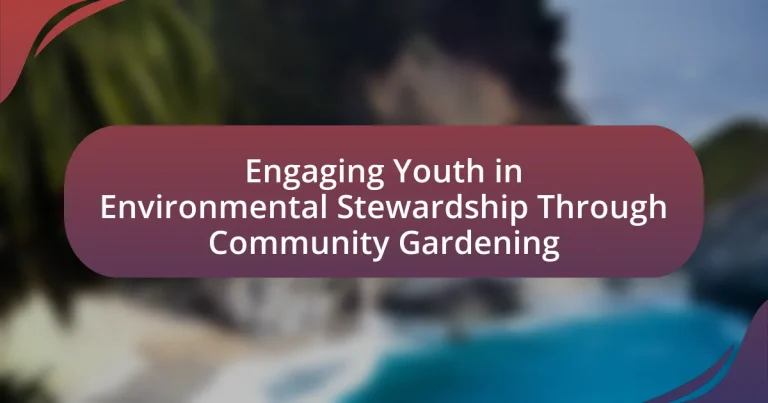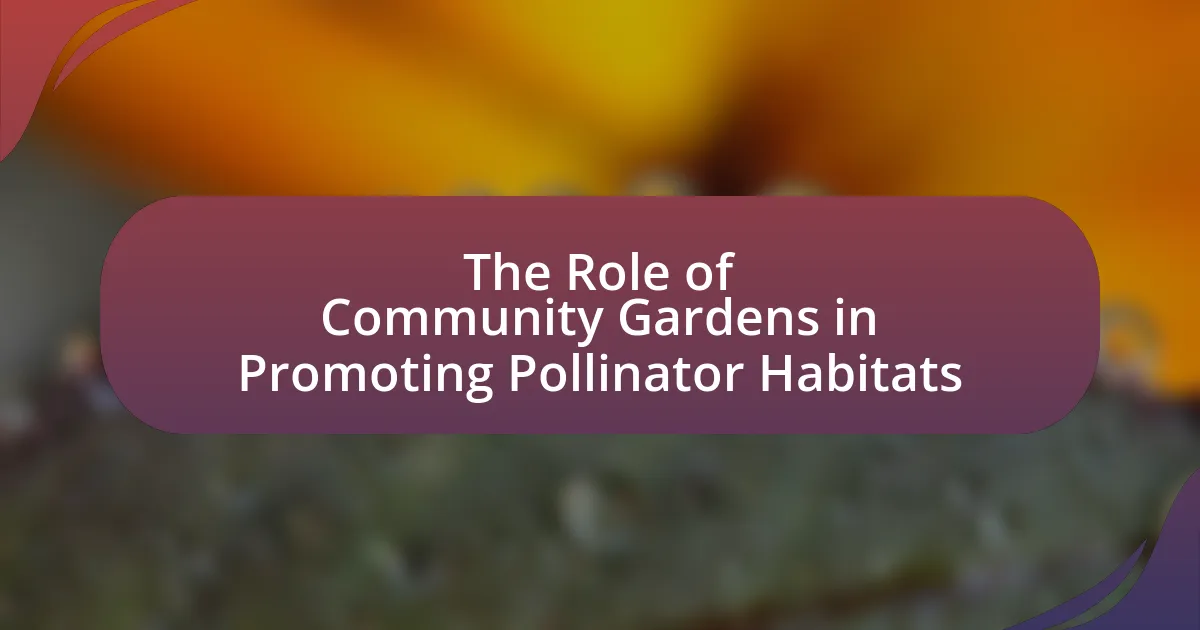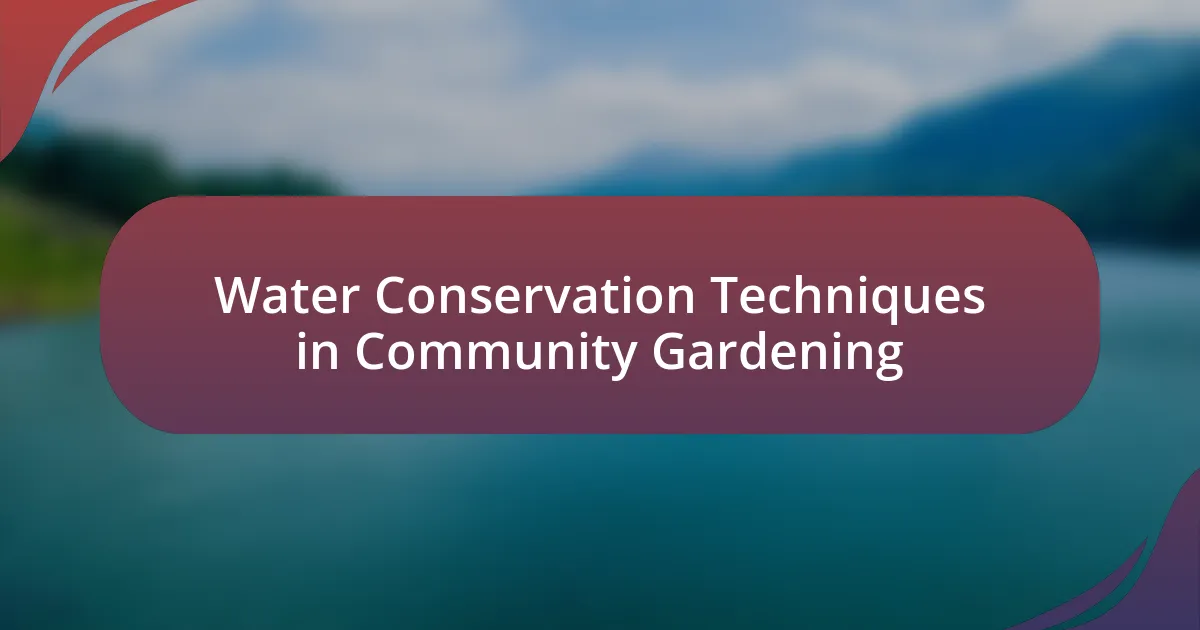Engaging youth in environmental stewardship through community gardening is a proactive approach that involves young individuals in the cultivation and maintenance of community gardens, fostering responsibility towards the environment. This initiative promotes hands-on learning about sustainable practices, biodiversity, and local food systems, leading to increased environmental awareness and pro-environmental behaviors among participants. Key principles include sustainable resource management, biodiversity promotion, and community engagement, which collectively enhance youth’s social skills, mental health, and commitment to environmental conservation. The article also addresses the importance of youth engagement in environmental initiatives, the role of schools and local organizations, and strategies to overcome challenges in community gardening, ultimately highlighting the benefits of such programs for holistic youth development.
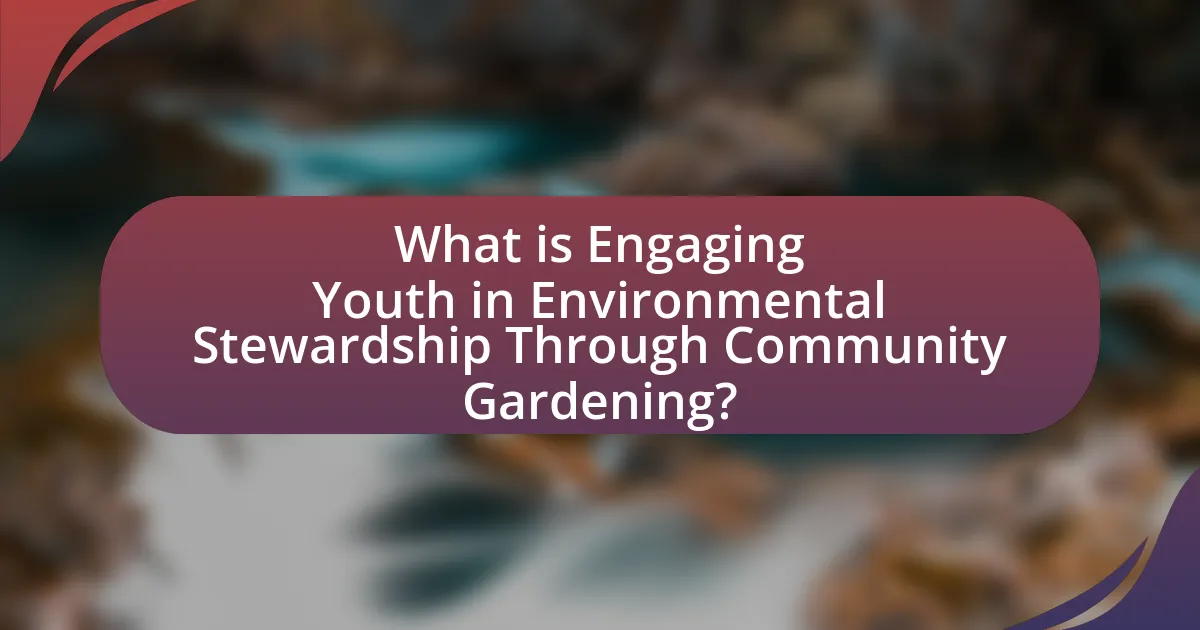
What is Engaging Youth in Environmental Stewardship Through Community Gardening?
Engaging youth in environmental stewardship through community gardening involves actively involving young people in the cultivation and maintenance of community gardens to foster a sense of responsibility towards the environment. This initiative promotes hands-on learning about sustainable practices, biodiversity, and the importance of local food systems. Research indicates that such programs enhance environmental awareness and encourage pro-environmental behaviors among participants, as evidenced by studies showing increased knowledge of ecological principles and improved attitudes towards nature among youth involved in community gardening projects.
How does community gardening promote environmental stewardship among youth?
Community gardening promotes environmental stewardship among youth by fostering a hands-on connection to nature and encouraging sustainable practices. Engaging in gardening activities allows youth to learn about ecosystems, biodiversity, and the importance of local food systems. Research indicates that youth involved in community gardening programs demonstrate increased awareness of environmental issues and a greater commitment to sustainable behaviors, such as recycling and conservation. For instance, a study published in the Journal of Environmental Education found that participants in community gardening initiatives showed a 30% increase in their understanding of environmental stewardship concepts. This practical experience not only enhances their knowledge but also instills a sense of responsibility towards the environment, ultimately shaping them into proactive stewards of their communities.
What are the key principles of environmental stewardship in community gardening?
The key principles of environmental stewardship in community gardening include sustainable resource management, biodiversity promotion, and community engagement. Sustainable resource management involves using practices that conserve water, soil, and energy, such as rainwater harvesting and composting, which enhance soil health and reduce waste. Biodiversity promotion focuses on cultivating a variety of plants to support local ecosystems and attract beneficial insects, thereby improving garden resilience. Community engagement emphasizes involving local residents, particularly youth, in gardening activities, fostering a sense of responsibility and connection to the environment. These principles collectively contribute to a healthier ecosystem and empower communities to take active roles in environmental conservation.
How does community gardening foster a sense of responsibility in youth?
Community gardening fosters a sense of responsibility in youth by involving them in the planning, planting, and maintenance of shared green spaces. This hands-on participation encourages youth to take ownership of their tasks, leading to a commitment to care for the garden and its environment. Research indicates that youth engaged in community gardening develop skills such as teamwork, problem-solving, and accountability, which are essential for responsible citizenship. For instance, a study published in the Journal of Environmental Education found that participants in community gardening programs reported increased feelings of responsibility towards their community and the environment, highlighting the positive impact of such initiatives on youth development.
Why is youth engagement important in environmental initiatives?
Youth engagement is important in environmental initiatives because it fosters a sense of responsibility and ownership over environmental issues among younger generations. Engaging youth allows them to contribute innovative ideas and solutions, which are crucial for addressing complex environmental challenges. Research indicates that when young people participate in environmental initiatives, such as community gardening, they develop critical skills and knowledge that empower them to advocate for sustainable practices. For instance, a study by the National Environmental Education Foundation found that youth involvement in environmental projects leads to increased awareness and proactive behaviors regarding sustainability. This engagement not only benefits the environment but also cultivates future leaders in environmental stewardship.
What role do young people play in shaping sustainable communities?
Young people play a crucial role in shaping sustainable communities by actively participating in environmental stewardship initiatives, such as community gardening. Their involvement fosters a sense of responsibility towards the environment and encourages sustainable practices among peers. Research indicates that youth-led community gardening projects not only enhance local biodiversity but also promote social cohesion and environmental awareness. For instance, a study published in the Journal of Environmental Education found that youth engagement in community gardening significantly increases knowledge about sustainable agriculture and environmental issues, leading to long-term behavioral changes in sustainability practices.
How can engaging youth in gardening influence their environmental attitudes?
Engaging youth in gardening can significantly enhance their environmental attitudes by fostering a direct connection to nature and promoting sustainable practices. When young individuals participate in gardening, they gain hands-on experience with plant growth, soil health, and the importance of biodiversity, which cultivates a sense of responsibility towards the environment. Research indicates that youth involved in gardening programs exhibit increased knowledge about ecological systems and demonstrate more positive attitudes towards environmental conservation. For instance, a study published in the Journal of Environmental Education found that students who participated in school gardening programs showed a 30% increase in their understanding of environmental issues compared to those who did not engage in such activities. This experiential learning not only shapes their perceptions but also encourages lifelong stewardship behaviors.
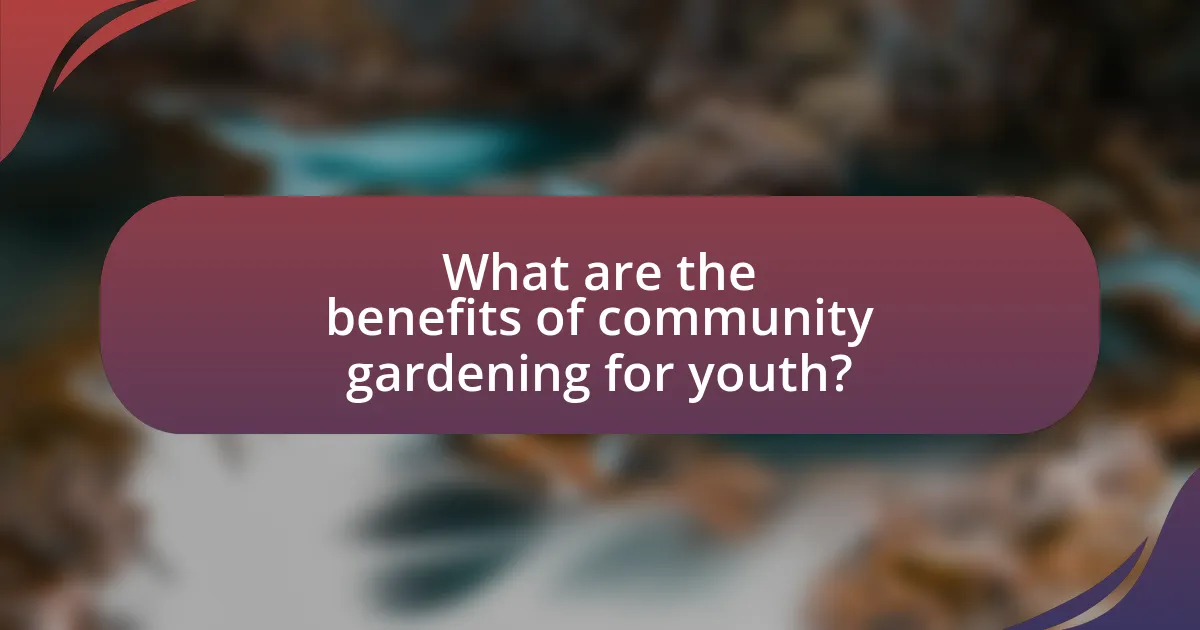
What are the benefits of community gardening for youth?
Community gardening provides numerous benefits for youth, including enhanced social skills, improved mental health, and increased environmental awareness. Engaging in community gardening fosters teamwork and communication as youth collaborate on gardening tasks, which helps build social connections and friendships. Additionally, studies show that spending time in green spaces can reduce stress and anxiety, contributing to better mental well-being among young participants. Furthermore, community gardening educates youth about sustainable practices and the importance of environmental stewardship, instilling a sense of responsibility towards nature and their communities. These benefits collectively support the holistic development of youth, preparing them for active and engaged citizenship.
How does community gardening enhance social skills among youth?
Community gardening enhances social skills among youth by providing a collaborative environment where they can interact, communicate, and work together towards common goals. This hands-on experience fosters teamwork, as youth learn to share responsibilities, negotiate tasks, and resolve conflicts, which are essential components of effective social interaction. Research indicates that participation in community gardening programs can lead to improved communication skills and increased confidence in social settings, as youth engage with peers and community members. For instance, a study published in the Journal of Environmental Education Research found that youth involved in community gardening reported higher levels of social engagement and improved interpersonal skills compared to those not involved in such activities.
What opportunities for teamwork and collaboration does community gardening provide?
Community gardening provides numerous opportunities for teamwork and collaboration by bringing together individuals from diverse backgrounds to work towards a common goal of cultivating plants and enhancing green spaces. This collaborative effort fosters communication, shared responsibilities, and collective problem-solving, as participants must coordinate tasks such as planting, watering, and harvesting. Research indicates that community gardens can improve social cohesion, with studies showing that neighborhoods with community gardens report increased social interactions and stronger community ties. For instance, a study published in the Journal of Community Psychology found that participants in community gardening projects experienced enhanced teamwork skills and a greater sense of belonging, demonstrating the effectiveness of these gardens in promoting collaboration among community members.
How can community gardening improve communication skills in youth?
Community gardening can improve communication skills in youth by providing a collaborative environment where they engage in discussions, share ideas, and solve problems together. In these settings, youth learn to articulate their thoughts and listen to others, fostering effective verbal and non-verbal communication. Research indicates that participation in community gardening enhances teamwork and social interaction, which are critical components of communication skills development. For instance, a study published in the Journal of Environmental Education Research found that youth involved in community gardening reported increased confidence in expressing their opinions and collaborating with peers, demonstrating the positive impact of such activities on their communication abilities.
What health benefits are associated with community gardening for young participants?
Community gardening offers significant health benefits for young participants, including improved physical fitness, enhanced mental well-being, and increased nutritional knowledge. Engaging in gardening activities promotes physical exercise, which can lead to better cardiovascular health and reduced obesity rates among youth. Studies indicate that children who participate in gardening are more likely to consume fruits and vegetables, thereby improving their overall diet quality. Additionally, community gardening has been linked to reduced stress and anxiety levels, fostering a sense of belonging and community among young individuals. Research published in the Journal of Environmental Psychology highlights that gardening activities can enhance mood and promote social interaction, further supporting mental health.
How does gardening contribute to physical health and well-being?
Gardening significantly contributes to physical health and well-being by promoting physical activity and reducing stress. Engaging in gardening tasks such as digging, planting, weeding, and harvesting can provide moderate exercise, which helps improve cardiovascular health, strength, and flexibility. Research indicates that gardening can burn approximately 200 to 400 calories per hour, depending on the intensity of the activity. Additionally, exposure to nature while gardening has been shown to lower cortisol levels, thereby reducing stress and enhancing mental well-being. Studies, such as those published in the Journal of Health Psychology, demonstrate that individuals who engage in gardening report higher levels of happiness and lower levels of anxiety, further supporting the positive impact of gardening on overall health.
What mental health benefits can youth gain from participating in community gardening?
Youth can gain significant mental health benefits from participating in community gardening, including reduced stress, improved mood, and enhanced social connections. Engaging in gardening activities has been shown to lower cortisol levels, which are associated with stress, thereby promoting relaxation and emotional well-being. Additionally, the act of nurturing plants can foster a sense of accomplishment and purpose, contributing to improved self-esteem. Research indicates that community gardening also encourages social interaction, which can combat feelings of isolation and loneliness, further supporting mental health. A study published in the Journal of Environmental Psychology found that participants in community gardening reported higher levels of life satisfaction and lower levels of anxiety and depression compared to those who did not engage in such activities.
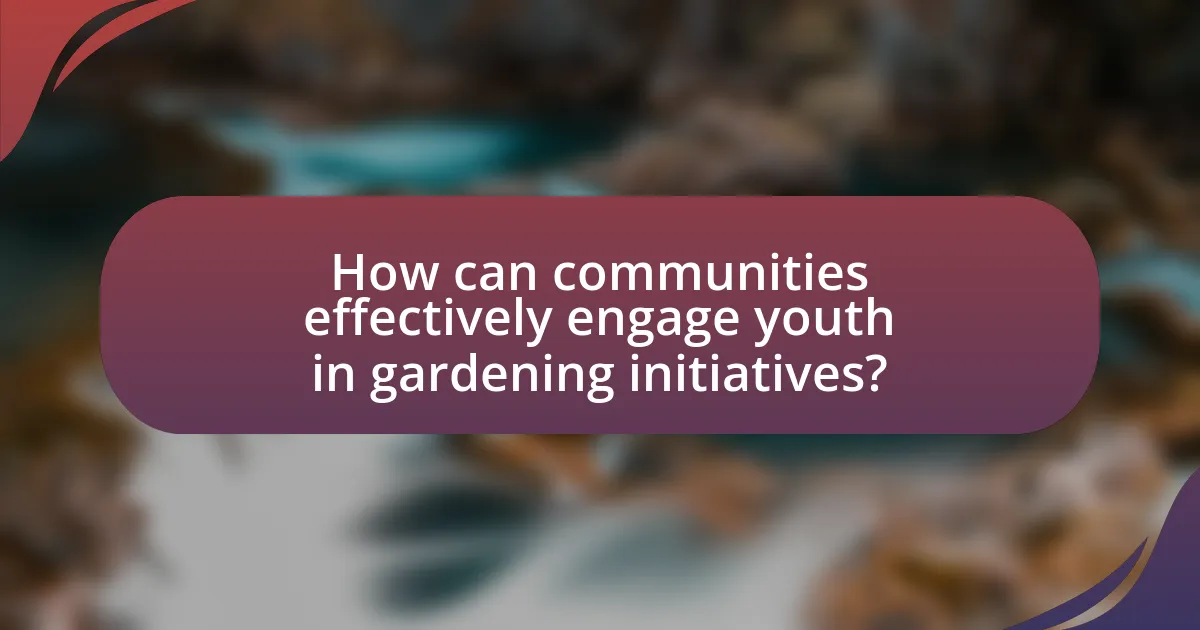
How can communities effectively engage youth in gardening initiatives?
Communities can effectively engage youth in gardening initiatives by creating hands-on, educational programs that emphasize the benefits of gardening and environmental stewardship. These programs can include workshops, school partnerships, and community events that allow youth to participate in planting, maintaining, and harvesting gardens. Research shows that youth involvement in gardening can enhance their understanding of nutrition, ecology, and teamwork, fostering a sense of responsibility and connection to their environment. For instance, a study published in the Journal of Environmental Education found that students who participated in school gardening programs showed increased knowledge of environmental science and improved attitudes towards healthy eating. By providing resources, mentorship, and opportunities for leadership, communities can cultivate a lasting interest in gardening among youth.
What strategies can be implemented to attract youth to community gardening?
To attract youth to community gardening, implementing hands-on educational programs that emphasize sustainability and environmental stewardship is essential. These programs can include workshops on organic gardening, composting, and the benefits of local food systems, which resonate with the values of younger generations. Research indicates that youth are more likely to engage in activities that provide them with practical skills and knowledge, fostering a sense of ownership and responsibility towards their environment. Additionally, incorporating social media campaigns to showcase gardening activities and successes can effectively reach and engage a younger audience, as studies show that 90% of teens use social media platforms. Collaborating with local schools to integrate gardening into the curriculum can also enhance participation, as educational institutions play a significant role in shaping youth interests and activities.
How can local organizations collaborate to create engaging gardening programs?
Local organizations can collaborate to create engaging gardening programs by forming partnerships that leverage shared resources, expertise, and community networks. For instance, schools can partner with local non-profits to integrate gardening into educational curricula, while community centers can host workshops led by experienced gardeners. Research shows that collaborative gardening initiatives can increase participation rates by 30% when organizations pool their resources and outreach efforts. Additionally, joint events, such as community planting days, can foster a sense of ownership and responsibility among participants, enhancing engagement and long-term commitment to gardening programs.
What role do schools play in promoting community gardening among students?
Schools play a crucial role in promoting community gardening among students by integrating gardening programs into their curricula and fostering a sense of environmental stewardship. Through hands-on gardening activities, schools provide students with practical knowledge about sustainable practices, biodiversity, and nutrition. Research indicates that students involved in school gardening programs show increased interest in environmental issues and improved academic performance in subjects like science and health. For example, a study published in the Journal of Environmental Education found that students participating in school gardens demonstrated a 20% increase in science test scores compared to their peers. This evidence underscores the effectiveness of schools in cultivating a culture of community gardening and environmental awareness among youth.
What challenges might arise in engaging youth in community gardening?
Engaging youth in community gardening may face challenges such as lack of interest, limited access to resources, and time constraints. Youth often prioritize other activities over gardening, which can diminish their participation. Additionally, community gardens may require tools, seeds, and educational materials that are not readily available, making it difficult for youth to engage fully. Time constraints due to school, extracurricular activities, and part-time jobs can further limit their ability to commit to gardening projects. These factors collectively hinder effective youth involvement in community gardening initiatives.
How can communities address barriers to youth participation in gardening?
Communities can address barriers to youth participation in gardening by implementing inclusive programs that provide access to resources, education, and mentorship. For instance, establishing community gardens in accessible locations and offering workshops can engage youth effectively. Research indicates that hands-on gardening experiences enhance youth interest in environmental stewardship, as demonstrated by a study published in the Journal of Environmental Education, which found that youth involved in gardening programs showed a 30% increase in environmental awareness. Additionally, partnerships with local schools and organizations can facilitate transportation and provide necessary tools, further reducing barriers to participation.
What solutions exist for overcoming common challenges in community gardening?
Solutions for overcoming common challenges in community gardening include establishing clear communication channels, creating structured leadership roles, and providing educational resources. Clear communication helps to align goals and expectations among participants, reducing misunderstandings. Structured leadership roles ensure accountability and effective management of tasks, which can enhance participation and commitment. Educational resources, such as workshops on gardening techniques and sustainable practices, empower community members with the knowledge needed to address issues like pest management and soil health. These strategies have been shown to improve community engagement and the overall success of gardening initiatives, as evidenced by various community gardening programs that report increased participation and better garden outcomes when these solutions are implemented.
What are some best practices for successful youth engagement in community gardening?
Successful youth engagement in community gardening involves creating inclusive, hands-on experiences that foster ownership and responsibility. Best practices include involving youth in the planning and decision-making processes, which enhances their investment in the project. Research shows that when young people contribute to garden design and management, they are more likely to participate actively and consistently. Additionally, providing educational workshops on gardening techniques and environmental sustainability can deepen their understanding and appreciation of the ecosystem. Programs that incorporate social activities, such as community events or competitions, also promote teamwork and build a sense of community among participants. Engaging local schools and organizations can further expand outreach and support, ensuring diverse participation and sustained interest in gardening initiatives.
How can mentorship enhance youth involvement in gardening projects?
Mentorship enhances youth involvement in gardening projects by providing guidance, knowledge, and motivation. Experienced mentors can share practical skills, such as planting techniques and pest management, which increases the youth’s confidence and competence in gardening. Research indicates that mentorship programs significantly improve youth engagement; for instance, a study by the University of California found that youth involved in mentorship-driven gardening initiatives showed a 40% increase in participation rates compared to those without mentorship. This structured support fosters a sense of community and responsibility, encouraging young individuals to take ownership of gardening projects and develop a lifelong interest in environmental stewardship.
What resources are available to support community gardening initiatives for youth?
Community gardening initiatives for youth can be supported through various resources, including grants, educational programs, and partnerships with local organizations. For instance, the USDA offers grants specifically for community gardens, which can provide funding for materials and educational workshops. Additionally, organizations like the American Community Gardening Association provide resources, training, and networking opportunities for youth-focused gardening projects. Research indicates that youth engagement in gardening can enhance their understanding of environmental stewardship, as highlighted in studies by the University of California Cooperative Extension, which found that youth involved in gardening programs showed increased knowledge of sustainable practices and healthy eating habits.
